Recent Mold Remediation Posts
Mold Can Be A Major Issue In Your Columbus Bathroom
1/22/2019 (Permalink)
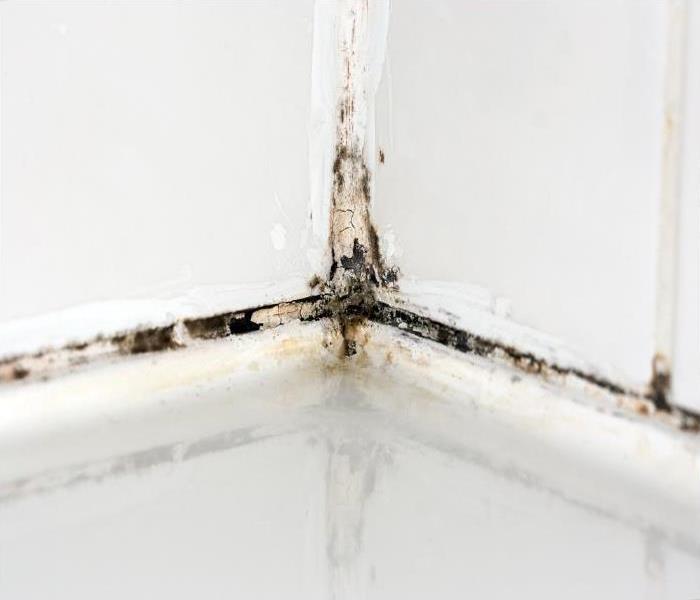 If you ever notice a black mold forming on the surface of your shower's ceiling, it is smart to call SERVPRO of South Columbus.
If you ever notice a black mold forming on the surface of your shower's ceiling, it is smart to call SERVPRO of South Columbus.
Mold Damage Experts In Columbus Discuss Problems With Shower Ceilings
Fungi can develop inside your Columbus apartment anywhere there is an organic substance and excessive moisture. For example, a small water leak that goes unnoticed in your bathroom can cause mold damage to take place inside your bathroom sink's vanity. Bathrooms are a prime location for fungal growth partly because it is a room inside your dwelling that contains several water sources. These rooms are also tight and confined spaces which makes it easier for humidity levels to rise. A fungus only needs an organic substance, moisture, the correct temperature, and the right amount of time to cause excessive mold damage to your building.
One common place for fungal development is your bathroom especially your bath/shower area. Seeing as how there is a lot of moisture in this region, any extra moisture added can cause mold damage inside your Columbus restroom. Most showers are made out of drywall such as organic materials like paper. Once elevated moisture levels or an unanticipated water leak strikes the region, it is possible that microbes can activate and form fungi. Once a fungus forms it starts growing structures called hyphae which grow in all three directions.
These hyphae can then spread microbes that work as seeds to form fungi in other wet areas. Calling in a professional remediation company like SERVPRO can help you from having problems in other areas of your home. Any time we work on restoring fungal issues, take extra measures to keep spores from getting into your building's airflow and negatively affecting your air quality system.
To accomplish such, our SERVPRO technicians build a containment chamber around the area that is contaminated by mold. When dealing with problems with your shower ceiling, we can contain the entire bathroom with a plastic barrier. Once the containment gets established, we attach an air scrubber that sucks hazardous particles through a HEPA filter that traps even microscopic particles. If you ever notice a black mold forming on the surface of your shower's ceiling, it is smart to call SERVPRO of South Columbus at (614) 863-1392 24/7.
Click here for more about Columbus.
Did You Know That A Fungus Could Be Growing Inside Your Columbus Home?
12/19/2018 (Permalink)
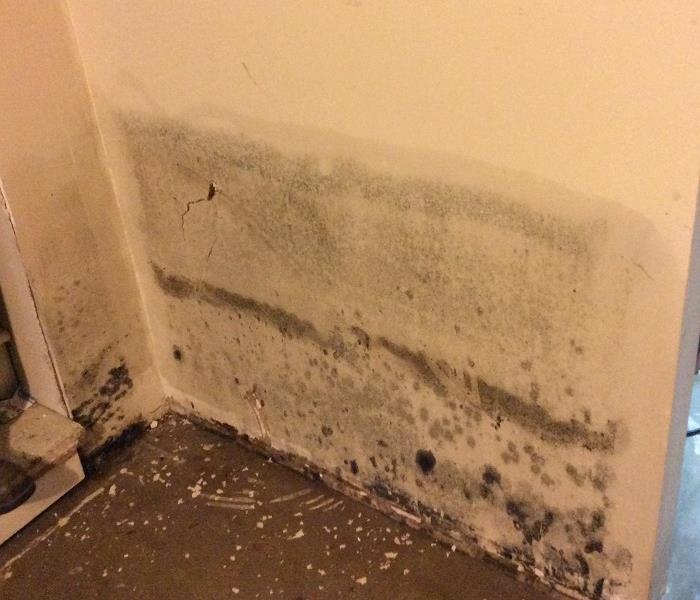 It only takes 48 hours for mold to form after a water leak.
It only takes 48 hours for mold to form after a water leak.
Mold Remediation Technicians In Columbus Discuss Problems With Minor Damage
If a small water leak inside your Columbus home goes undetected for more than 48 hours, conditions are right for microbes to form. Once fungi develop, it is wise to call in a professional mold remediation company like SERVPRO. A fungus can grow in any area inside a house that has organic substances and elevated moisture levels. Once the microbes activate and turn into a fungus, they form structures called hyphae that can grow deep into and attach to materials with root-like structures. The hyphae then release spores into the air and can force you to have to conduct mold remediation in more areas inside your home in the future.
Even if the contamination is small, the spores can get into your house's airflow and cause air quality issues. Since fungi can cause health effects, it is wise to call in SERVPRO, which is a professional mold remediation company in Columbus, to help prevent the problems from getting worse. Our team starts by finding the initial source of the water damage that caused materials to get wet. We then follow the moisture to figure out which items inside your home got affected by moisture or fungal contamination. Once we come up with our project scope, we take measures to repair the original water leak so that no more moisture enters the interior of the structure.
Once the initial problem gets repaired, our SERVPRO technicians work on removing the contaminated materials and taking measures to prevent the spreading of mold spores. Before any work begins, we build a plastic barrier to contain the affected area. We then attach an air scrubber to the containment chamber to create negative air pressure inside it. Any dust generated during the restoration process then gets pulled through a HEPA filter that traps microscopic particles.
Our team then removes the contaminated materials before we treat any other areas near the source with an antimicrobial chemical. If you ever notice even a small spot of black mold inside your home, call SERVPRO of South Columbus at (614) 863-1392 any time of the day.
Columbus was named for Christopher Columbus. Click here to read more.
Mold Damage Starts With A Tiny Colony In Your Columbus Residence
7/18/2018 (Permalink)
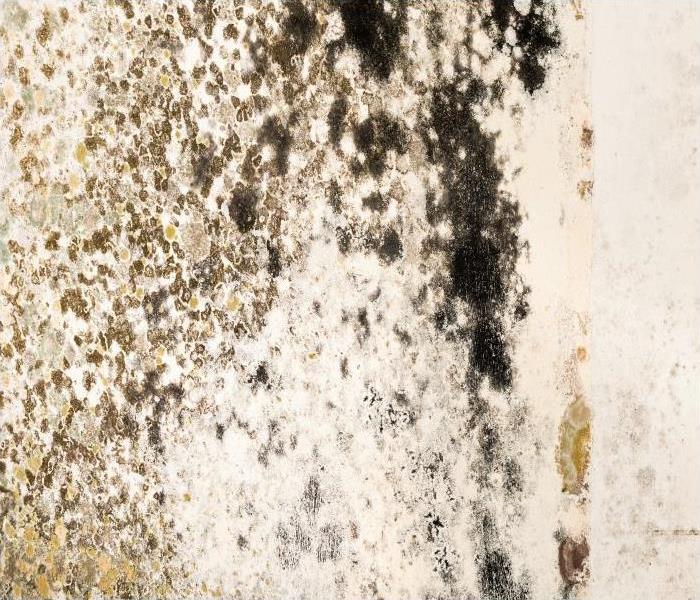 Microbial life exists all over the world, including our homes in Columbus.
Microbial life exists all over the world, including our homes in Columbus.
Mold Damage In Your Residence
Microbial life exists all over the world, including our homes in Columbus. The type of environment that we need to live comfortably helps keep these microbes from growing out of control and harming our homes.
In a home in Columbus, only a few variations can get conditions that cause mold damage to unfold rapidly. While the microbes always exist, it is nearly always the presence of moisture that creates this situation to plague a homeowner. The microbes merely need moisture to activate them to begin feeding on the already-present food supply found in your home's drywall, plaster, and wood components. Even the dust in your carpeting can supply mold and other microbes with substantial amounts of food.
A few actively growing microbes do not do much by themselves. However, these microbes rapidly reproduce by producing spores. These spores do not stay close to their place of origin. Instead, they end up thrust into the air and then carried to the same locations that air currents also carry excess moisture. This situation is what causes mold damage to become such a widespread problem in many homes so quickly.
At SERVPRO, we train our technicians in how to both rapidly and effectively perform mold damage remediation services. These methods protect both our workers and your home in unaffected areas while efficiently ridding your home of an infestation.
We are also expert at keeping costs as low as possible by cleaning mold growth away from materials that otherwise sustained no damage. Not everything in an area affected by mold damage requires removal, disposal, and replacement. Restoring damage and then preventing regrowth often suffices just as effectively while cutting the replacement costs out of the equation. At SERVPRO, we want to make things “Like it never even happened.” as inexpensively as possible for our customers while still ensuring their homes no longer contain excessive microbial populations.
We do this by clearing the air of microbes and spores, so they no longer can settle throughout your home and start new colonies. We also ensure that any sources of unwanted water or moisture no longer pose a threat to your home's interior. These and other measures help us succeed in eliminating current mold damage from your residence and prevent it from returning.
SERVPRO of South Columbus serves the Bexley and Grove City areas, and can always be reached at (614) 863-1392 to help residents with mold damage remediation.
Click here for more about Columbus.
Removing the Musty Odor From Mold Growth in Your Columbus Home
6/11/2018 (Permalink)
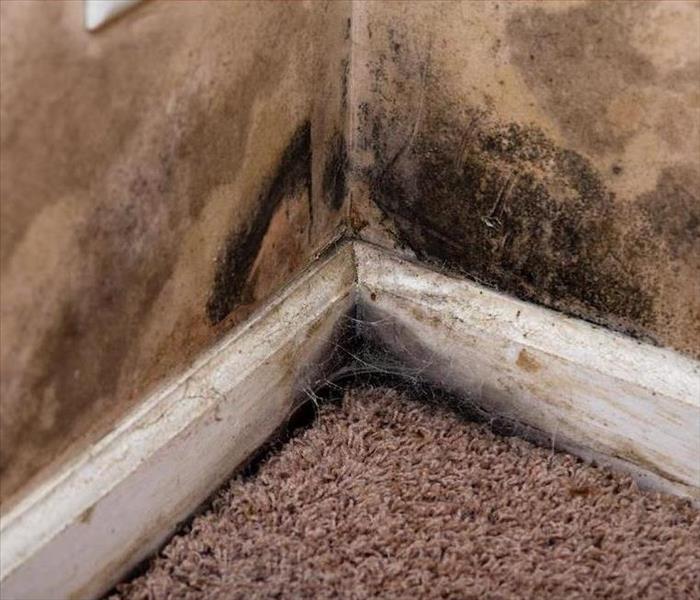 Whether mold is in your walls, carpets or cabinets, the smell can be overwhelming. Contact SERVPRO immediately for great smelling results.
Whether mold is in your walls, carpets or cabinets, the smell can be overwhelming. Contact SERVPRO immediately for great smelling results.
Quick SERVPRO Response to a Mold Infestation can Help Remove Odors Faster and More Thoroughly
As disturbing as it might be to find mold growing in your Columbus home, often this is not the thing that bothers homeowners the most. Typically, one of the most abrasive effects of mold colonization is the harsh musty odor that resonates from the thriving colony and spreads throughout this affected area of your home. In many cases, this same odor might have been the reason that you learned about the microbial growth in the first place.
While you might get fixated on removing the present growth from your house, you are also equally as inclined to want this odor removed from the residence as well. As one of the more uncomfortable effects of mold damage to your Columbus home, our SERVPRO team gets well equipped to deal with the deodorization that your house requires when colonization has occurred.
From the moment that we arrive at your home, much work has to get started almost immediately to limit the spread of mold to new areas of your house. Once this area gets isolated with air scrubbers, our team of applied microbial remediation technicians can work quickly to remove the mold colonies from where they have seated throughout your home.
Once the bulk of the remediation process has completed, our SERVPRO professionals are ready to start the deodorization. This procedure often involves the use of thermal foggers that can break apart the odor molecules in the environment with a dense chemical compound released from the machine. This process leaves no odor behind and is safe to use on furniture, clothing, fabrics, and carpets.
Our professionals get uniquely trained to the highest of industry standards set in place by the IICRC. This certification ensures that each member of our experienced team has the skill set to handle all forms of mold growth and the most efficient approach to colony removal and remediation. Trust our SERVPRO of South Columbus team of restoration specialists when you discover microbial growth in your home. Give us a call anytime at (614) 863-1392.
Click here for more about Columbus.
Cleaning and Removing Mold Damage in Columbus Homes
5/4/2018 (Permalink)
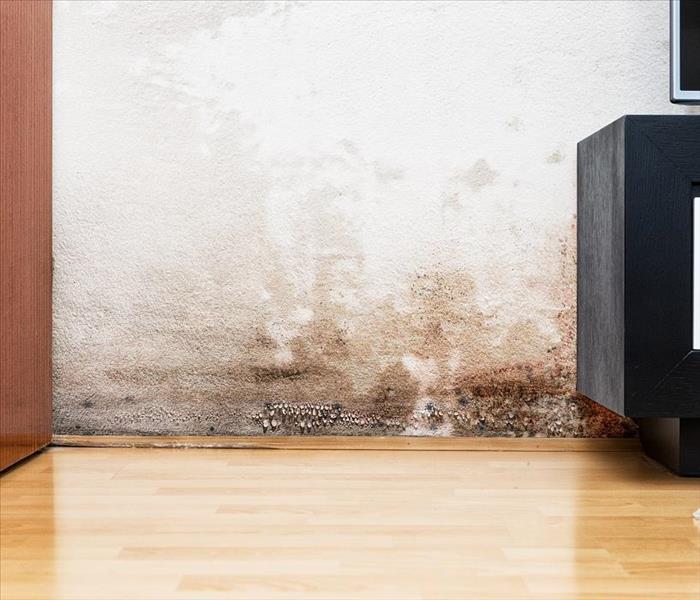 If mold spores have grown into a food source, such as ceiling tiles, wood or drywall, SERVPRO quickly removes them.
If mold spores have grown into a food source, such as ceiling tiles, wood or drywall, SERVPRO quickly removes them.
SERVPRO is Here to Help Restore Your Home after Mold Damage
Even the word mold can scare Columbus homeowners. The effects of it can be disconcerting and damaging to residences and property.
Columbus mold damage needs to be removed and cleaned quickly, but the reasons are primarily to protect the home and personal property. SERVPRO also knows that mold can cause health effects in some people.
To begin with, our technicians have to halt current growth. They do this by finding and drying up the source of moisture that allows the mold spores to expand and start searching for a source of food. Even a small amount of water, like a pool that collects under a rusted connection or a leak in the attic roof. In most of these cases, the repairs are minor, and our teams can quickly fix them. For major plumbing or roofing issues, SERVPRO recommends the homeowner uses a licensed general contractor.
After they halt the growth, our restoration teams wipe down every affected surface and clean them of any spores. Often, the growth is in a dry, powdery form that wipes up easily with either a dry sponge or an anti-fungal agent to break up thicker growths and then remove them with a sponge or cloth.
When the mold is in a difficult to reach place like under a floor or in an attic, technicians use a stronger anti-fungal agent with a fogger machine to create a cloud which can reach every surface in these tight, enclosed spaces. They also use the fogging method to reach mold growing behind walls.
If the mold spores had time to grow into the food source, like ceiling tile, wood, or drywall, technicians quickly remove them. They carefully break up and bag the pieces to avoid accidentally spreading the mold. After removing the growth, our technicians spray the surfaces behind the affected pieces to kill any remaining spores.
The goal of SERVPRO of South Columbus is to restore every home possible to its original, pre-mold condition. If you can see the effects of a mold infestation in your home, call us at (614) 863-1392 today. We are here for you.
Click here for more information on the city of Columbus.
What You Can Do When You Discover Mold Growing In Your Columbus Home
4/3/2018 (Permalink)
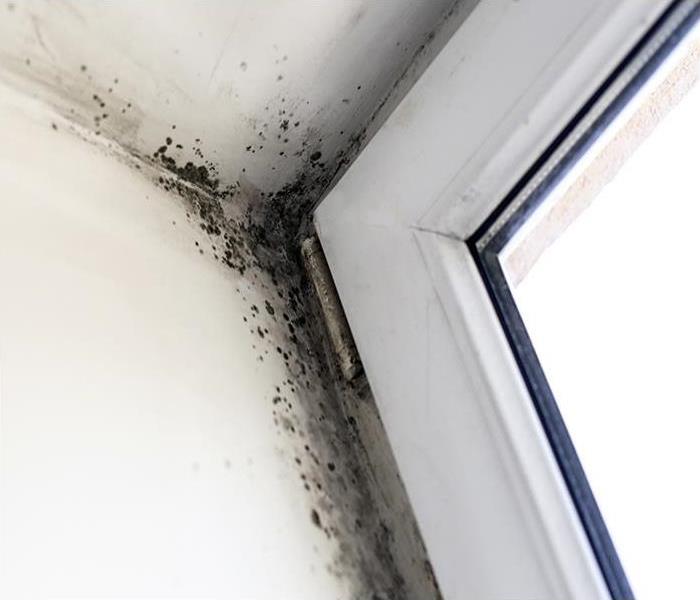 Mold damage can come about in a variety of ways inside of your home.
Mold damage can come about in a variety of ways inside of your home.
Discovering Mold Growing In Your Home
Mold damage can come about in a variety of ways inside of your home. For example, excessive humidity can encourage spores to grow, and water damage from a leaking pipe can give them the necessary moisture to flourish. The problem with mold growing in your home is that it can cause health effects. Because of this problem, it is safer to have it removed as soon as possible upon finding it. Fortunately, professional help is close at hand and just a phone call away.
Due to being settled on a river, humidity puts homes in Columbus at a higher risk for damaging mold growth. Beyond health effects, another reason it is so important to deal with mold immediately is that it is directly responsible for the decomposition of organic materials such as wood. To preserve the longevity of your home, our technicians can section off the area of your home with mold and begin a remediation process.
The reason it is essential for our SERVPRO technicians to contain the mold is that spores can travel through the air once they are disturbed; thick plastic sheeting can be used to close off barriers. Afterward, depending on the material that is affected, the removal process can begin, and our technicians can select the right method to do so.
Usually, if the affected surface is porous, the material needs to be removed and discarded. Otherwise, it is possible to merely clean mold away. For cleaning mold, SERVPRO uses HEPA vacuuming on dry surfaces. If the mold exists in layers of soils, we can damp wipe the area with detergent. After the mold is agitated and removed, all that remains is to clean settled dust and spores that have settled.
If you find mold damage inside of your home, do not wait. Day or night, contact SERVPRO of South Columbus at (614) 863-1392. We can send our technicians as soon as possible to begin the remediation process swiftly.
Click here for more about Columbus.
Why Is It Important to Seek Professional Help After Mold Damage to Your Columbus Home?
2/27/2018 (Permalink)
 Mold spores are present everywhere, but with the right conditions can form into mold colonies.
Mold spores are present everywhere, but with the right conditions can form into mold colonies.
Understanding How Mold Grows and Spreads in Your Home
Mold is one of the most neglected home maintenance problems that can quickly become a catastrophe. Spotting the damage early is the key to safe and effective remediation.
Mold damage restoration of your Columbus home is not a DIY project. Efficient and successful remediation is a job for the professionals with years of experience and the right safety equipment. Trying to eliminate mold by yourself can help it spread to unaffected areas amplifying the problem. It is essential to understand the basics of mold and take the right precautions for fast and safe remediation.
What causes mold growth?
Mold begins its life from a microscopic spore; they are like seeds that can germinate in the right conditions. Interestingly, mold spores are present everywhere. So, it may not be possible to eliminate them entirely, but it is entirely possible to prevent the creation of conditions favorable for their germination.
One of the most important conditions for the spores to germinate is moisture. If the surfaces contain a high level of humidity, the spores can absorb it, swell and germinate giving rise to a network of filamentous structures called hyphae. Some of the hyphae grow into the surface providing an anchor for the network, while others can bear spores on their tops.
If the network of the hyphae is disturbed, these spores can become airborne and settle in other parts of your home. While cleaning the mold growth, SERVPRO professionals use a barrier system to prevent these spores from reaching the uncontaminated parts of your home. They also have the necessary equipment to clean the settled spores and prevent them from reaching other parts of your home.
Mold loves warm and moist environments.
Mold requires the right combination of temperature and moisture to germinate and grow. The ideal temperature being between 68 and 86 degrees. With these conditions in place, the settled sores can quickly germinate and form a network of hyphae in no time.
The most important thing to control is the moisture level. SERVPRO Professionals can determine the residual moisture level in your home using state-of-the-art moisture sensing equipment. If the levels are high, they can correct them by addressing the underlying problem.
Call SERVPRO of South Columbus at (614) 863-1393 today to set up a free consultation.
Click here for more on the city of Columbus.
Regain Control Of Your Columbus Area Home Using Professional Mold Remediation Services
1/30/2018 (Permalink)
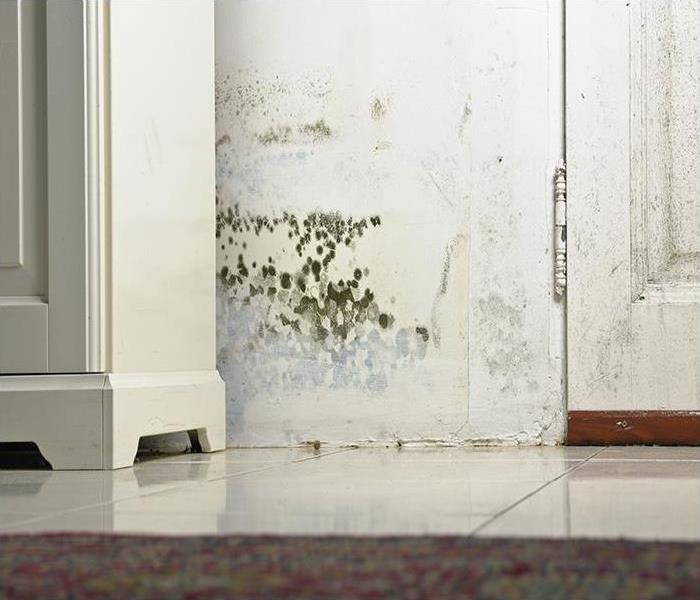 Mold damage can become a severe problem.
Mold damage can become a severe problem.
Professional Mold Remediation Services
Living in Columbus comes with a variety of benefits including, pop, spaghetti chili, big boy hamburgers, and being among those that enjoy an original buckeye. However, it also means that you most likely live in a stucco home that is highly susceptible to mold.
Real stucco is comparable to cement, offering homeowners an option with very little maintenance and excellent protection for their Columbus area home. Unfortunately, mold damage can become a severe problem. Improper installation and time both take their toll, allowing mold to seep behind the stucco, entering interior walls of your home, often without you ever knowing a problem exists.
With mold spores entering your home from the outside, every plumbing leak or minor water issue spawns growth, leaving patches of mold throughout your home that can significantly affect the overall indoor air quality and living environment in your home. Calling a company, like SERVPRO, can give you the upper hand when dealing with mold issues and help you regain control.
Mold can survive for weeks inside of your walls, just waiting for the right conditions to exist to allow it to spread. With mold being a naturally occurring element of our ecosystem, it becomes a common problem that many homeowners face. SERVPRO’s IICRC-industry certified technicians can help you locate hidden pockets of mold, repair damages, and even help you prevent future growth.
Remember, just because you cannot see mold, does not mean that you are mold free. The majority of mold particles are invisible to the naked eye and require specialized tools to identify the problem accurately. SERVPRO has expertly trained mold remediation specialists, advanced equipment, and years of experience dealing with mold damage situations throughout the area.
Take the time to contact SERVPRO of South Columbus, today. We can perform a full inspection of your property or begin your home’s mold remediation, immediately. Call us 24/7, day or night, including holidays. We have the answers you need to protect your investment, family, and home (614) 863-1392.
Visit https://www.columbus.gov/ for more about Columbus.
Stopping Mold Damage in Columbus
10/16/2017 (Permalink)
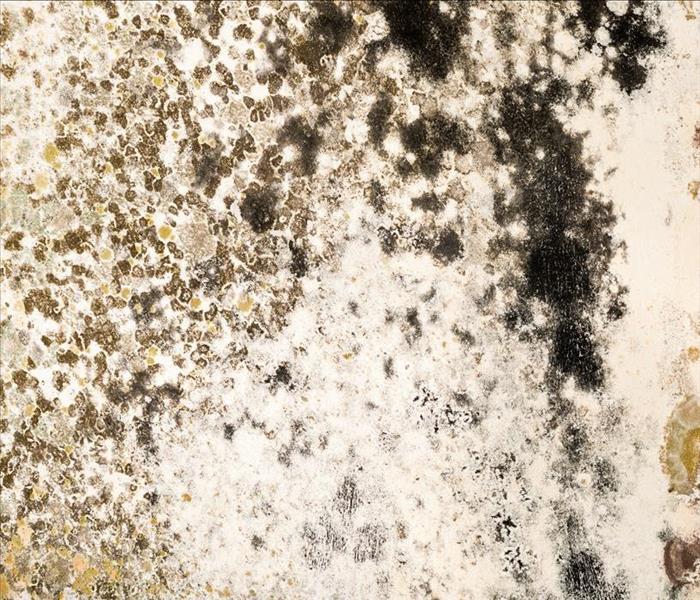 Mold Grabs on to Your Columbus Home When Sufficient Moisture and a Food Source Are Present--Mold Remediation from SERVPRO
Mold Grabs on to Your Columbus Home When Sufficient Moisture and a Food Source Are Present--Mold Remediation from SERVPRO
SERVPRO Offers Remediation and Restoration After a Mold Attack
Mold is a quiet disaster. It does not crackle like a fire or roar into a Columbus home like a storm. Unlike fire and water, everything mold needs are already inside the house. Spores only need a little water, a food source, and a very conducive temperature between 68 to 86 degrees.
With those factors in place, mold damage in Columbus homes is a given. Spores rapidly expand out of their inactive state and begin growing, looking for food in less than a day. SERVPRO has extensive experience in combating mold by altering, stopping, and removing one or more of these factors.
Temperature is the hardest to change. Our technicians can raise the temperature of a room or house by a few degrees using the house heating system and then a bit more with space heaters. Doing this soon becomes expensive for the homeowner and cannot be maintained for more than a few days.
Since the reasoning behind changing the temperature is to dry affected rooms and surfaces, SERVPRO relies on air movers to force warm, dry air across them to remove sources of moisture. This method uses less power and is more efficient on walls and floors.
Finding the growth and removing what it is feeding on is probably the easiest, not to mention the cheapest factor for our response team. No food means no growth, but since residents cannot live in a house without interior walls or a ceiling, the replacement tiles and drywall eventually become infested if we do not find the source of the mold. Fortunately, drywall panels are inexpensive, though replacing may not be.
The best way to stop mold spores is to find and cut off the source of water. Our inspectors usually find a leaking pipe underneath a sink or in a laundry room. Sometimes, the source is a small pool of water that got into an attic through a minor point of damage on the roof. It does not take long to remove a water source after we find it. Our technicians quickly remove small pools, and they can replace most damaged pipes in a single afternoon.
Depending on the extent of the infestation, removing mold from your home can take a few days or a couple of weeks. SERVPRO of South Columbus has the personnel, training, and equipment needed to put you back into your home as soon as we can safely do so. If you have questions about what we can do for you and your home, call us today at (614) 863-1392.
Facts about this large city in Ohio, click here.
How Guidelines And Standards Help Us Remediate Mold Damage In Columbus Homes
8/18/2017 (Permalink)
 Mold is a fungus, and all it needs to grow is moisture and an organic food source.
Mold is a fungus, and all it needs to grow is moisture and an organic food source.
Remediate Mold Damage
Mold can happen to any household. Mold is a fungus, and all it needs to grow is moisture and an organic food source. Potential food sources include drywall, carpet, furniture, some types of insulation, and even wood. Water sources are easy to come by in any kitchen, bathroom, laundry room, or any home with a leaky door or window.
Thus it is easy to see how quickly mold damage can happen to Columbus homes. The telltale signs of a mold such as black or greenish patches or a musty, moldy smell, are warning signs to a homeowner that it is time to take action. Because fungus occurs naturally in many environments, it is not possible to eradicate it completely. However, it is feasible to remediate the existing mold situation and take steps to discourage regrowth.
At SERVPRO, we have spent many years perfecting our mold remediation process, and we always adhere to strict guidelines. Following due process ensures that we complete every step. The result is a thorough remediation process that benefits local householders and makes us the natural choice for any fungus cleaning needs.
SERVPRO teams adhere to two guidelines: Environmental Protection Agency (EPA) advice on mold, and the Institute of Inspection, Cleaning, and Restoration Certification (IICRC) S502 Mold Remediation Standard. All our technicians are trained to IICRC standards so you can rest assured that you are dealing with trained professionals.
The EPA standards tell us to clean and dry all moldy materials, remove and dispose of all non-salvageable items and dry any non-moldy articles in the vicinity within 24 hours. Our teams achieve this by establishing containment and venting contaminated air outside of your home, before setting to work scrubbing, brushing, dry wiping, and HEPA vacuuming away all visible mold. Dehumidifiers help reduce humidity and dry out the area, which also prevents further growth.
IICRC standards go into more detail (that is why we choose them for our training). As well as controlling contamination, removing fungus, and drying the area, the IICRC tells us to provide for health and safety, and document the conditions and the process. Our teams are trained in health and safety and wear appropriate personal protective equipment to every job. Also, we carefully monitor and log the conditions in every home and monitor moisture levels throughout the job.
For help with any mold situation, call SERVPRO of South Columbus at (614) 863-1392 today.
For more about the city of Columbus visit https://www.columbus.gov/.
Mold Damage is More than Fuzzy Growths Underneath Your Kitchen Sink in Columbus
7/11/2017 (Permalink)
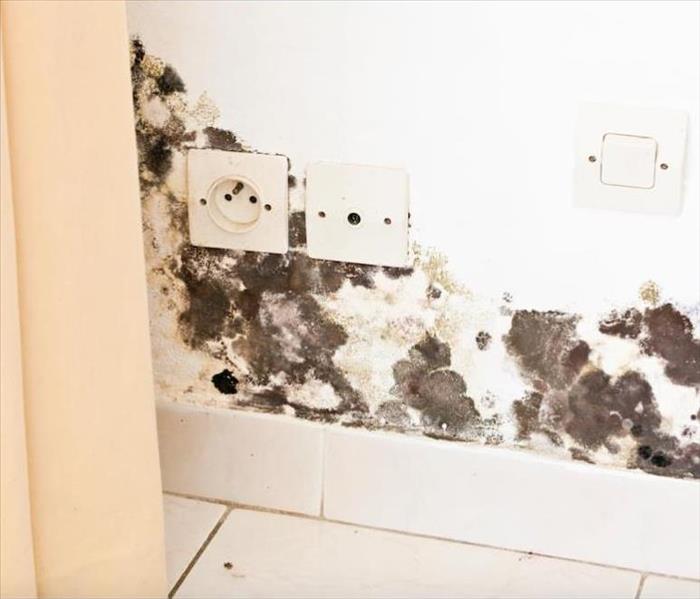 Finding mold in your home can fill you with anxiety. Contact SERVPRO and let us start the remediaiton process so that you can relax once again.
Finding mold in your home can fill you with anxiety. Contact SERVPRO and let us start the remediaiton process so that you can relax once again.
SERVPRO Technicians Remediate Different Types of Mold Damage on a Daily Basis
Mold is one of those aspects of life that everyone hopes they never have to experience. Mold grows everywhere because it is present everywhere, meaning the chances of finding more than easy-to-wash-away patches of it are probably much higher than you would like.
Homes in Columbus can have mold damage long before patches of it are discovered. Mold comes in many different varieties, also, and having one type growing in your home never precludes that other variations exist inside your walls, either. You might find them growing side by side, mixed in with each other or at opposite corners of your home. There may be mold living in your basement, and also in your attic. This organism can grow wherever it has access to moisture and cellulose, but preferably in dark areas that are rarely disturbed.
Dark, damp locations in your home are not limited to only under sinks. Closets are also favorite spots for mold to grow in. When mold takes over a closet, SERVPRO can restore the damaged walls, replace the carpet and apply a mold inhibitor. Eliminating any water sources, such as a leaking water pipe on the interior of the wall is also something that we can do, which also helps to prevent future mold growth.
As for the items that were inside of your closet, clothing, shoes, boots, belts and hats, and the like, these accessories can become infiltrated with mold. Care should be taken so that these items are treated with care while being bagged up. We have access to an Esporta that can eliminate the mold your items have become contaminated with and then return them to you in a clean and sanitary condition.
This method of cleaning your belongings produces no shrinkage of any material and can be extended to items that are commonly stored in garages, attics, and basements. Your sporting equipment can be salvaged, as can your camping gear, hiking books and equipment, and much more. We know sports gear is an investment and often carries significant sentimental value, as well. When mold damages your home, we are aware that contents and belongings are often affected, too.
Mold damage is not something you and your family need to tolerate. Call SERVPRO of South Columbus at (614) 863-1392, and we can begin to remediate your home of mold and eliminate the damage it can so easily create.
For more information regarding Columbus, click here
Mold Growing on Drywall in Your Columbus Home
5/16/2017 (Permalink)
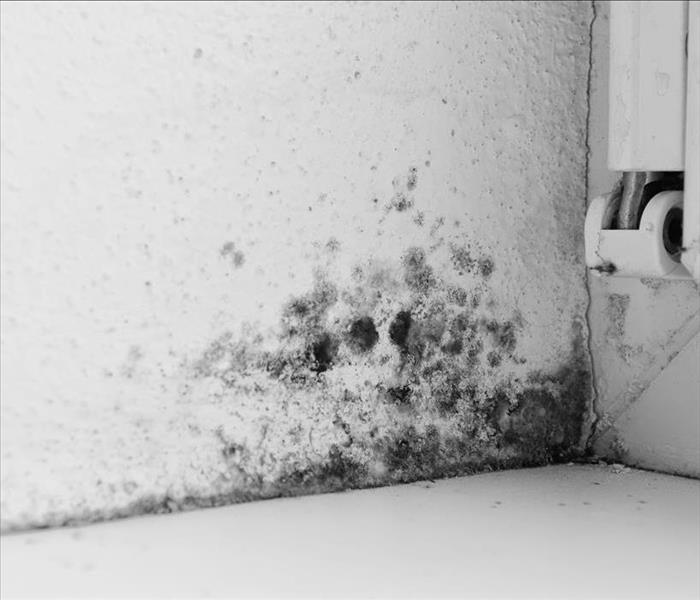 Moisture Causes Mold Growth on Walls, Call SERVPRO for Remediation in Your Columbus Property
Moisture Causes Mold Growth on Walls, Call SERVPRO for Remediation in Your Columbus Property
Dampness Encourages the Proliferation of Mold
Mold on drywall can create plenty of unnecessary structural damage and health effects if it is left untreated, even for a short time. Black mold, though it has gained unwarranted notoriety, is usually associated with this kind of damage. All fungi should be remediated to create a better home environment.
Short-term drywall damage can be caused by water, and long-term damage is the result of mold growth in your Columbus home being left to spread and multiply, leaving behind mold damage. When drywall is exposed to moisture, it shows water stains. After an extended period, the panels can be destroyed. The sandwiched cardboard separates from the gypsum, and the core loses its structural integrity.
Drywall which has lost structural integrity begins to sag slowly over time and needs replacing. Wet drywall, with its paper backing, can be an ideal breeding ground for mold. Fungi secrete digestive chemicals onto the organic source to feed, then reabsorbs them along with digestive materials for food. The process is not possible until the materials become damp or wet. Mold can start to grow on drywall in just twenty-four to forty-eight hours. Drying the walls out as fast as possible is the key to a solution which is effective.
Sheetrock wicks up water as well, meaning it picks up water even if it has not come into contact with water. Since drywall absorbs water from the air, it is critical to have your drywall evaluated and inspected if you have had any standing water or flooding in your home recently. Rapid water removal reduces the chances of mold growth.
Water can wick into drywall from the air or contact as fast as one inch per hour, which means if water sat in your home for just one day, it could absorb into your drywall as much as two feet high, creating a great breeding ground for mold.
SERVPRO of South Columbus is standing by always to help you get water and moisture out of your home to prevent mold damage. With moisture meters, thermal hygrometers, and other special tools, they can even detect hidden moisture in your walls to ensure that they dry your home thoroughly in as little time as possible. Just give them a call at (614) 863-1392 anytime, day or night, when you notice wet drywall or the presence of mold.
SERVPRO Helps Prevent Mold Damage To Columbus Carpets
4/20/2017 (Permalink)
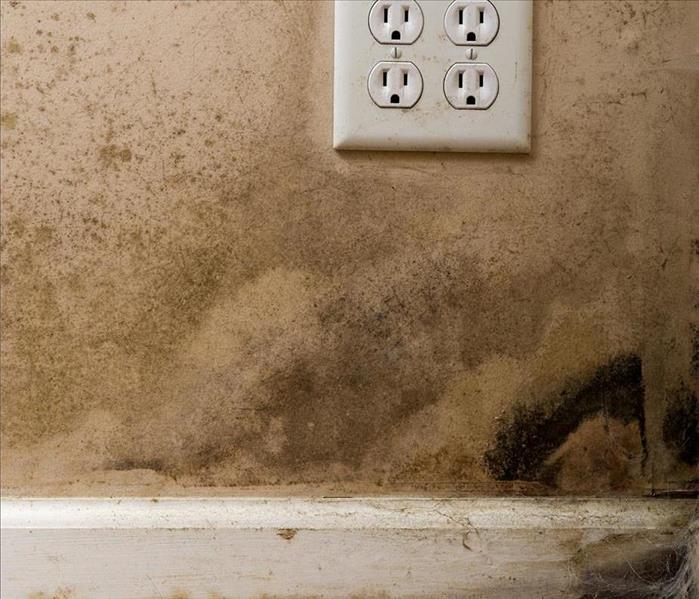 Mold in a Columbus Home Wall Can Spread to Carpets
Mold in a Columbus Home Wall Can Spread to Carpets
Mold Remediation in Columbus Homes Requires Professional Help
Mold spores are tenacious and can quickly grow and spread throughout your home. However, if mold has not already set in, it is possible to prevent it taking hold by ensuring it does not have the right environment in which to grow. A wet carpet is an ideal breeding ground for fungi. Flood damage, a burst pipe, or even a leaking appliance in your home are all causes of potential water leakage onto your carpet. The result is a damp environment, which mold spores love.
Swift action is necessary to prevent mold damage to the carpets in your Columbus home. In fact, it can begin to grow within 24 hours of water damage and become a colony in 48 to 72 hours. The longer water is present, the greater the risk of increased fungal growth. As well as having potential health effects, mold is simply not something you want to grow in your carpet and may even lead to a costly carpet replacement. That is why SERVPRO recommends calling on our experts the moment you notice water damage to any of your floor coverings.
The key to preventing mold growth in water damaged carpets is to get the carpet dried out as quickly as possible. The first step is extracting the water by using truck mounted and freestanding pumps. Our IICRC-certified experts understand that careful handling is vital when removing water from carpets. Carpets can come with a primary and secondary backing. Over zealous extraction techniques or pulling of the carpet during extraction can cause separation of these two layers, leading to bubbling and irreparable carpet damage.
Most carpet comes with padding on its underside. In most cases, our experts recommend the padding is taken away and replaced. Drying with the padding in place takes longer and thus makes the drying slower and more expensive with an increased risk of mold growth. It is often cheaper to replace the padding and focus on drying the carpet. SERVPRO teams carefully remove padding to leave the carpet intact. Of course, the degree of wetness and the amount of the fungal growth dictate if tossing is required.
After water extraction and pad removal are complete, our technicians calculate the correct number and position of air movers and dehumidifiers to dry out the carpet. Downdraft air movers pull warm air down and spread it across the carpet in a broad pattern which makes them ideal for larger areas. Meantime, centrifugal air movers direct air over the carpet surface to encourage rapid evaporation of moisture. Our aim is swift and thorough drying to leave your carpet "Like it never even happened."
If you are concerned about potential mold growth in your carpet, call SERVPRO of South Columbus at (614) 863-1392 today for assistance.
When Mold Grows, Damage Follows – Protect Your Home in Columbus
2/8/2017 (Permalink)
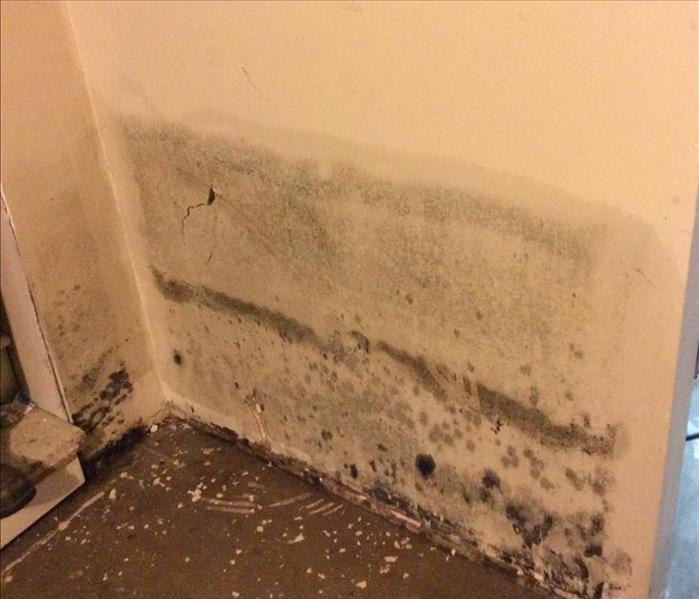 Let the experts at SERVPRO help with any Mold Remediation needs.
Let the experts at SERVPRO help with any Mold Remediation needs.
Having houseplants inside over the winter is beneficial for both you and your plants. They receive protection and warmth from the harsh winter weather and you gain a natural air filter that provides oxygen and beauty. One thing that you might not know is that mold can also hitch a ride with your plants and spoil things for you. Plants don't like to be moved much, so after you've brought them inside in the late summer or early fall, chances are you've left them exactly where you originally placed them.
If you've placed them on a tray, you might not have a problem in your Columbus area home, but mold damage can hide under pots and planters. If these are sitting directly on the wood in your bay or bow windows, you could end up with a nasty surprise when you go to take them back outside again in the spring. Having such easy access to water and a wooden windowsill makes a perfect feeding ground for mold. Couple that with the warmth of the sun, but the darkness from being under a plant, and you've set up perfect conditions for mold.
If your windowsill has slats or joints, these can provide additional entryways for mold to migrate to other areas of the window. This is one way that seals on windows deteriorate. It can also cause window frames to warp, which may eventually allow in melting snow, rainwater, or pests. It can also lead to the heating and cooling systems in your home needing to work harder than they should. This will also cost you more money in utility costs that could be prevented.
If your wintering plants are beginning to smell strange, it could be mold that is the cause. If you find mold growing on tiles or another hard, non-porous surface, it most likely is safe to clean up with a damp cloth. When the windowsill involved is made of wood or other porous material, it can quickly turn into a much more complicated project, one that should have professional assistance. No job is considered to be too small at SERVPRO, nor too large. We are always available to help when mold damage is creating a problem in your home.
To protect your home from mold damage of any kind, give us a call. SERVPRO of South Columbus is always available and can be reached at (614) 863-1392.
When Homes Develop Mold, Damage can Spread Quickly
8/2/2016 (Permalink)
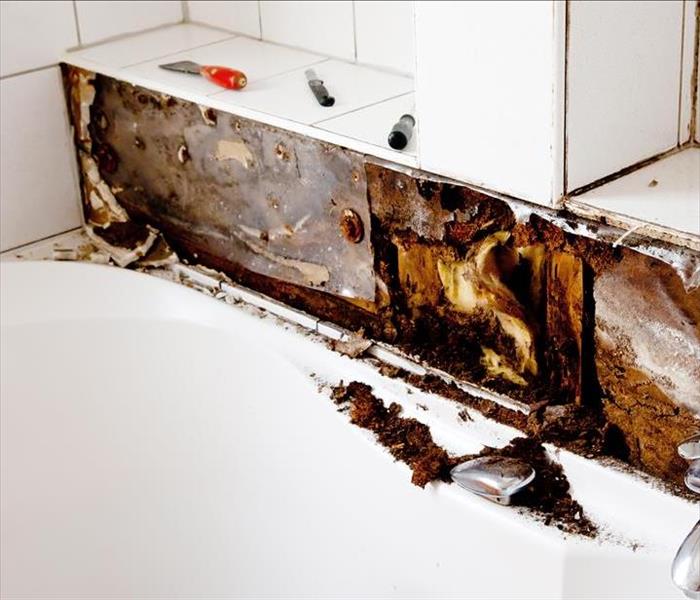 When Mold Had Ruined Your Bathroom in Your Groveport Home, Call SERVPRO for Remediation
When Mold Had Ruined Your Bathroom in Your Groveport Home, Call SERVPRO for Remediation
Call SERVPRO To Inspect and Remediate Mold Damage in Your Home
Because of the media attention on black mold of recent past, many homeowners believe that it is only black mold that can cause health effects. However, while this is true, the CDC recommends that all mold, of any and all types, be remediated. This is because black mold is not the only one that can cause those worrisome health effects – it just receives the most notoriety. Many mold problems need professional remediation by experienced technicians in order to prevent future damage and contain any current damage.
SERVPRO has certified and specially trained personnel who can remediate the mold in your home to acceptable levels, and then remove and restore any damaged areas back to their original state.
Mold growth in your Groveport home can damage your home's interior without proper remediation techniques. There are many ways that mold can become a problem very quickly in any home, even when you have a house that seems to be dry.
One way this can happen is when your clothes dryer doesn't completely dry the clothes by the time you pull clothing out of it. Clothing that isn't completely dry can act as a magnet to mold. Not only is there moisture present, but many types of clothing fibers can provide food for mold to consume. Ensuring that all clothing must be both laundered and dried correctly can reduce this risk. Many textiles are ruined after fungi visibly discolor it, and repairs are often difficult or impossible.
Washing the dishes by hand after supper and then putting them away should include ensuring they are dry beforehand. Damp plates and glasses and other items can allow moisture to evaporate in a closed cupboard or cabinet. This moisture can create a safe, dark, and damp haven for mold to grow. A dark cabinet often only needs moisture to add to its other environmental attributes to do this. Make sure you either air or towel dry your items to keep moisture, and mold, out of your cabinets.
Mold can start in many other ways in any home. If you can smell the musty odor of mold, but cannot locate it at the source, you should have your home inspected. SERVPRO professionals have moisture detecting instruments that can help detect mold colonies, as well as other problems in your home. Give us a call today at SERVPRO of South Columbus at (614) 863-1392, 24/7 hours a day, every day. We'll arrive promptly and put your concerns about mold at ease.
Mold, Fungi, Virus, Bacteria Issues?
5/13/2016 (Permalink)
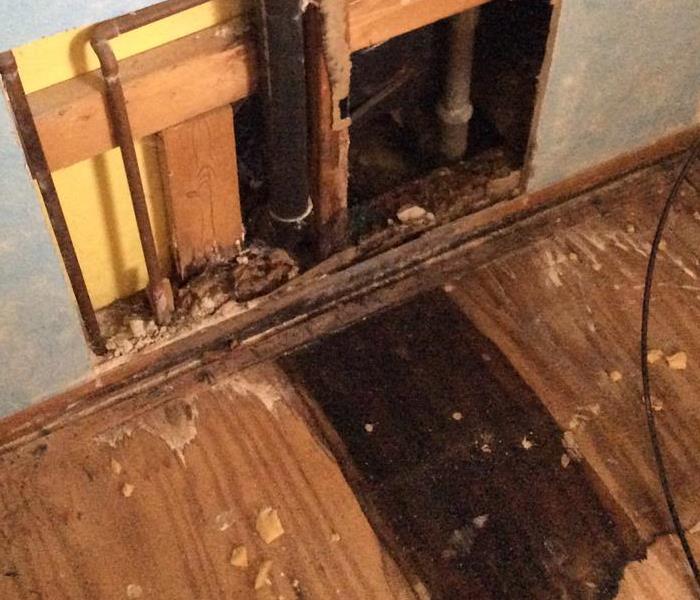 Mold from a leaking pipe in German Village
Mold from a leaking pipe in German Village
Nature, the cycle of life, the natural order, and other expressions you have heard through the years, all refer to how things survive, thrive and die in the natural environment. Humans encounter mold, fungi, bacteria, and viruses in German Village every day. However, when high concentrations of such microbes are present within buildings, it can cause health effects. Not all molds, fungi, viruses, and bacteria are harmful to us, but we often don't know what type of microbial to which we have been exposed, or to what degree (how much, or how long).
So what should we do? We use our noses! If you can smell that familiar musty odor that mold can cause, it usually means it is off-gassing and is a good indication that mold is active and growing in a fairly high concentration. Proper mold remediation in German Village requires the use of PPE (personal protective equipment), like respirators, goggles, gloves, etc. to protect against exposure to microorganisms. There can be unknown strains in areas of increased growth, like a sewage backup, a flood, long-standing water in a basement, dead and rotten animals, and so on. We also know that volatile organic compounds (VOCs) can be airborne, water borne, or surface borne; therefore we take all precautions to avoid exposure, and especially over exposure.
The next time you think about jumping right in to start cleaning mold or sewage, before you stir things up too much I hope you will pause and reflect on safety for yourself and others; OR better yet, call the professionals at SERVPRO of South Columbus. 614-863-1392 www.SERVPROsouthcolumbus.com
Mold, Virus, Bacteria
5/12/2016 (Permalink)
One of the most challenging problems that can impact a homeowner's life is unknown or left alone water damage. Unfortunately, many residential property owners don't know what to do when this disaster strikes And some believe "it will dry and be okay" However, learning more about water damage can prepare you to resolve any issue that surfaces quickly and correctly. Read this quick information guide to get the information you need on this important matter.
Numerous types of water damage can adversely impact your property once excess water is on the premises. For example, personal contents stored near the water can be subjected to extensive damage and even destruction. This includes items like clothing, drapes, furniture, and boxed items. Water can also adversely impact your electrical appliances and electrical connections. Additionally, wooden items like structure beams and flooring can become susceptible to rotting as a result of water damage.
Another danger that can result from water damage is the onset of health risks. For example, excess water can lead to bacteria that generates illness for those who are repeatedly exposed to it. Standing water also creates the ideal environment for mold to thrive in very quickly. When exposed to mold for extended periods of time, household members can experience a broad range of unwanted health issues. More importantly, mold can be very challenging to remove.
Let SERVPRO's Professionals Assist You Now
As made plain by the information above, water damage is a serious issue that can do extreme harm to your health and your home. However, attaining a high-caliber water damage restoration service can help ensure that you and your residential living space are kept in excellent condition. The company to call for expedient, exceptional restoration support is SERVPRO. Our IICRC-certified professionals work with skill and diligence to address and resolve each property issue you have. We're ready to assist you now, so call us today and let's get started!
Mold Cleaning and Remediation is a Job for Professionals
5/12/2016 (Permalink)
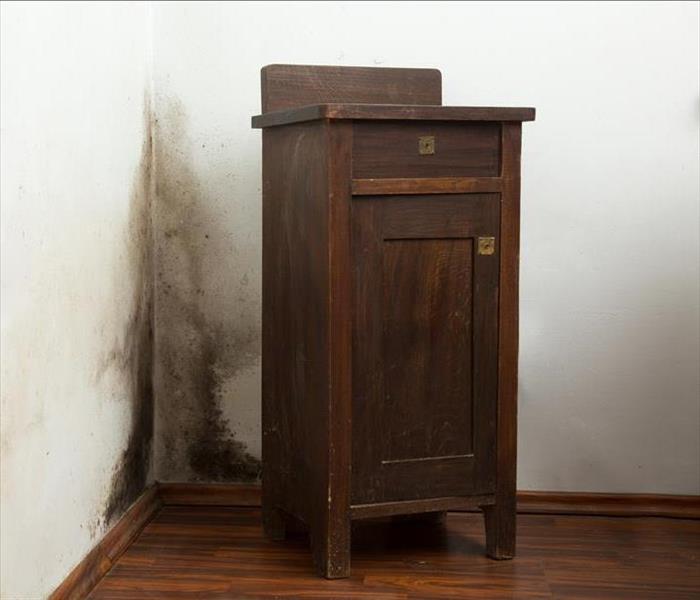 A leaking pipe that went undetected for an extended time period allowed extensive mold growth that was concealed by furniture.
A leaking pipe that went undetected for an extended time period allowed extensive mold growth that was concealed by furniture.
Visible mold growing inside your home or business may pose serious health risks for some people, and it should be properly removed as soon as possible.
Mold spores in Columbus or elsewhere, which are similar to the seeds of a plant, are microscopic in size and ever-present in the air and on surfaces, both inside and outside of buildings. All that is necessary for mold spore to take root and grow is a growth medium, sufficient moisture, and time. A bit of dust, or soil, or food residue on any surface (even concrete or tile) is enough to serve as a growth medium for mold or other microbes. Porous materials such as carpet or drywall can be an excellent growth medium. Humid conditions combined with warmer temperatures can accelerate the growth of some types of mold. When moisture remains in a suitable growth medium for more than a day or so, mold and other microbial growth is possible and likely, which is why keeping surfaces of indoor environments clean and dry is important.
Once mold in Columbus becomes visible to the naked eye, it is usually active and growing. The expression "Black Mold" is often used when it is visible. When this occurs in the built environment, it may be cause for concern, and you should contact a mold remediation professional, to perform an inspection.
The restoration technician will begin by checking for wet conditions in the building. Since moisture plays a key role in the growth of microbes, the amount of moisture present in the air, the building contents, and the building materials must all be taken into consideration. The technician will attempt to determine the source of the excess moisture. Any leaks or other sources of excess moisture must be addressed.
The technician may employ any of several methods and devices to measure the moisture in each of the areas above. The tool used most commonly by technicians for measuring moisture in the air is a thermo-hygrometer (sometimes called a psychrometer), which is essentially an electronic psychrometric calculator. The primary readings use by the technician are temperature and relative humidity. The readings from the psychrometer may also be inserted into a psychrometric chart. From this, the technician can see the relationship between relative humidity, temperature, dew point, and the humidity ratio. Relative humidity is the percentage of moisture in the air compared to how much moisture the air is capable of holding at a given temperature. Dew point is the temperature at which water will begin to condense from the air onto surfaces. The humidity ratio is the actual amount of water vapor in one pound of dry air, usually expressed as a ratio of grains of water vapor per pound of air (GPP).
There are several tools used to determine the moisture content of the materials in the building. A non-penetrating moisture meter will measure to a depth of approximately 3/4 of an inch. Most have separate settings for wood, drywall, or masonry. Wood moisture content is measured as a percentage, while other materials use a points scale.
A pin-type penetrating moisture meter is employed to check for moisture deeper than 3/4 nch, or if there are wet materials behind a wall or under a floor. It has probes that must be driven into or even completely through one material to check for moisture in another, such as insulation behind drywall, or subfloor materials beneath a vinyl rug.
Another method for finding wet materials that may not be visible to the naked eye is with an infrared camera. Infrared cameras are extremely sensitive, with the ability to detect temperature differences to as little as .05 degree Fahrenheit. They can enable the technician to locate wetness in buildings that cannot be found using conventional moisture meters.
The moisture levels in most materials must be measured against a 'dry standard', which will vary with local environmental conditions. The dry standard for materials in a building along the Gulf of Mexico will usually allow for a higher normal moisture content than for materials found in a building in the Desert Southwest for example. The technician will take readings from an area of the structure, or a neighboring structure, that has not been affected by the water damage event to set a 'drying goal' for each type of material, which will approximate the dry standard.
When a building incurs a water loss, the level of wetness is classified, and the level of contamination is categorized according to standards established in the S500, a manual by the Institute for Inspection, Cleaning and Restoration Certification and Training (IICRC). Water damages are divided into 4 Classes.
- Class 1 water damage is the least amount of wetness, confined mainly to the floor with only part of a room or area affected and little or no wet carpet or carpet pad.
- Class 2 is a large amount of water, with very wet flooring materials in at least an entire room and moisture wicking up the walls no more than 24 inches.
- A Class 3 water loss is the greatest amount of water, with entire rooms saturated from ceiling to floor, where water may have leaked down from above.
- Class 4 is a Specialty Drying situation, with hard to dry materials such as concrete, plaster or masonry, and deep pockets of saturation, which may require very low humidity or heat to dry.
Water contamination is broken into three categories:
- Category 1 water is water from a clean or sanitary source, which may be from a broken supply line, or toilet tank or bowl. Category 1 water can degrade over time to Category 2 or 3 with exposure to higher temperatures or contaminants, such as animal feces or animal carcasses.
- Category 2 water is mildly contaminated, and may cause illness or discomfort if ingested. Sources of Category 2 water may include a washing machine or dishwasher overflow, toilet overflow with no feces or a small amount of urine. Category 2 water can degrade to Category 3.
- Category 3 is grossly contaminated water which would likely cause serious illness or death if ingested. Examples include sewage, intruding water from flooding rivers or streams, toilet back-ups that include feces, or water that has been sitting long enough to support microbial growth. Water associated with a significant mold loss is generally considered to be Category 3.
If mold is discovered or suspected, samples must be taken from surfaces inside the building, and from the air both outside and inside of the building. The process of taking samples may require somewhat intrusive measures, such as moving furniture, lifting carpeting, opening air condition ducting, or even removing sections of drywall or flooring. The samples are taken to a laboratory and examined under a microscope by to identify the type and quantity of any microbes present. The results for the interior and exterior samples are compared against each other. The quantity of mold spore for a given volume of air should be somewhat less indoors than outside. The type and quantity of microbes normally present in the local environment are also taken into consideration. It is not uncommon in cases of serious interior mold infestations that the quantity of mold spores discovered in the interior air samples is significantly higher than the outdoor sample. Another indicator of an interior mold problem is the presence of a significant quantity of spores from the indoor air sample that are of a different type than the majority of spores present in the outdoor air sample.
When the results of the laboratory analysis are positive for mold, a remediation protocol is developed. This protocol must be followed by the mold remediation professional.
Before the remediation can begin, any standing water must be removed from the environment. Air scrubbers may also be installed inside the building. Air scrubbers are high-efficiency particulate arresting (HEPA) air filters, which remove 99.97% of particles from the air, down to a size of .03 microns. This filtration level is fine enough to capture mold spore, which can help reduce the amount of it in the air, and the likelihood that the mold will spread.
Technicians must don the proper personal protective equipment (PPE) before beginning the remediation. This usually includes impermeable gloves and suit, a respirator and eye protection. The remediation technicians will construct a containment barrier around the affected area, to close-off unaffected areas from the remediation process. Slight negative air pressure should be maintained within the containment, with any air exiting the chamber also filtered through an air scrubber, to reduce the likelihood of cross-contamination of unaffected areas.
Any wet and contaminated, porous materials, such as carpet or upholstered furniture, must usually be discarded. Materials to be discarded must be sealed in a container (such as a trash bag) while still within the containment area. Once removed from the building, it can be tossed out with normal construction waste.
Standing water must be extracted. Extraction is normally accomplished using a powerful portable unit that is capable of pulling a strong vacuum. Truck mounted extraction is less common in the presence of mold.
Once standing water has been removed, any remaining residual moisture must be removed from materials to be saved through dehumidification. Commercial dehumidifiers are usually employed to achieve low relative humidity levels. Low grain refrigerant (LGR) dehumidifiers are used with larger losses and higher moisture levels, as they are capable of discharging air at even lower humidity levels. However, refrigerant dehumidifiers must operate within a relatively narrow temperature range to achieve maximum effectiveness. Desiccant dehumidifiers are capable of achieving extremely low humidity levels in a wide range of temperatures, but they require a method to discharge moist air from the environment, which may not always be feasible, especially in the presence of mold.
When materials such as concrete or plaster become saturated with moisture, they can be difficult to dry, and will usually take much longer than materials such as wood, drywall or carpet. Heat may be added to the drying process in this case. However, heating the materials or the drying environment can also stimulate mold growth, and should not be employed on a mold job until humidity levels have been reduced below 50%. Air movement may also be applied to aid in moisture removal, although this too is often curtailed in the presence of mold, to prevent spreading and cross-contamination.
It is not uncommon for the subfloor and structural members of a building to be contaminated with mold as well. Solid wood flooring or structural wood can be sanded or otherwise abraded to remove mold. HEPA vacuum equipment is employed to capture all of the dust and debris created by this process. The depth of material that must be removed will be specified in the protocol. Since the integrity of some structural members can be compromised by sanding or grinding, it may be necessary to consult with an engineer to determine how much material can be safely removed before having to be replaced.
The goal of a mold remediation is to remove the mold from all surfaces, or remove and discard material where the mold cannot be remediated. In some cases, it is extremely difficult or impossible to remove material or remediate the mold from it. In those cases, the mold may be sealed off using an approved an encapsulant.
Once the remediation is complete, the containment barrier can be disassembled, and any reconstruction can begin.
 If you ever notice a black mold forming on the surface of your shower's ceiling, it is smart to call SERVPRO of South Columbus.
If you ever notice a black mold forming on the surface of your shower's ceiling, it is smart to call SERVPRO of South Columbus.



 24/7 Emergency Service
24/7 Emergency Service












